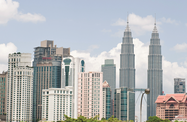In a year when Asia was home to the fastest-growing economies in the world, Malaysia made financial sector watchers stand up and take notice on several occasions.
For starters, it was the only emerging market to make it into the top 20 countries in the World Economic Forum's Financial Development Index 2010, moving up five notches from 22nd to 17th place. Malaysia also ranked number 21 in the World Bank’s Doing Business Index for 2010, ahead of Germany (at 22).
Trade among emerging markets, an obliging financing environment – Malaysia came in first for getting credit in the Doing Business Index – increased capital spending and stable commodity prices are also expected to keep the domestic economy robust into 2011, though the first half of next year may see some slowing in growth.
This year though, much of the excitement came in the form of new government plans and programmes. On June 10, the much-anticipated 10th Malaysia Plan (10MP) was unveiled, after the curtain-raising Government Transformation Programme (GTP) had been announced in January. A five-year, $72bn development map for socioeconomic growth, the 10MP aims to make Malaysia a high-income and high-productivity economy. The plan targets 6% annual GDP growth and raising per capita income to $12,000, identifying 12 national key economic areas that have the potential to generate high income.
Following in September was the Economic Transformation Programme (ETP), an ambitious 10-year plan to restructure the economy and raise the country to developed-nation status through investments in selected sectors. ETP leans heavily on the private sector for its success, with investors expected raise in the area of $410bn of the total $444bn budget.
At the end of the year, total GDP growth was predicted at between 6% and 7%, according to the central bank, Bank Negara Malaysia (BNM). This was despite contractions in government spending that put the brakes on GDP growth in Q3, with GDP growing 5.3% compared with 8.9% in Q2. This weaker growth was expected to extend into the first quarter of 2011, but a pickup is expected in the second half of 2011.
Not to be outdone, foreign direct investment (FDI) staged an astonishing rally, increasing 141% from RM7.1bn in the period January-September 2009 to RM17.1bn for the same period this year. FDI inflows are expected to surge to more than RM20bn in 2010, reflecting increased confidence in the economy and early success of the government’s economic initiatives.
To get these results, some tinkering was required by the central bank. After raising the Overnight Policy Rate (OPR) three times in 2010, the BNM had maintained it at 2.75% as of December. On the other hand, the BNM has taken a laissez-faire approach to the ringgit, allowing it to appreciate on a trade-weighted basis and stating that it will not intervene to make exports more attractive. In Q3, the ringgit had appreciated 5.5% against the US dollar.
Capital markets were transformed with the announcement that Malaysia’s Bursa will be moved into the FTSE Advanced Emerging Market Indices in June 2011. On top of this news, Petronas’ chemicals arm, PCG, raised RM12.8bn in Southeast Asia's largest-ever initial public offering (IPO) – part of the Prime Minister Najib Razak’s plan to attract foreign investment by selling state-owned assets.
The Kuala Lumpur Composite Index (KLCI), widely considered to be the capital market barometer, started the year out on shaky ground with two major low dips into the low to mid-1200s in February and June, but was ending the year near three-year highs at about 1510.
As part of the government’s planned liberalisation of the financial services sector, the BNM in June issued commercial banking licenses to five foreign commercial banks. The banks were France's BNP Paribas SA, Indonesia's PT Bank Mandiri, Japan's Mizuho Corporate Bank and Sumitomo Mitsui Banking Corp. and Abu Dhabi’s National Bank. Two new Islamic banking licences are reportedly set to follow.
Meanwhile, despite the strengthening ringgit, total trade for the first nine months of 2010 increased by 23% to RM864.48bn. Exports and imports grew by 20.4% and 26.4%, respectively.
Exporters can look forward to the Trans-Pacific Partnership (TPP) negotiations, which are likely to be concluded by the end of 2011. When completed, TPP is expected to result in an improvement in the climate of trade and investment among Malaysia, the United States, Australia, Brunei, Chile, New Zealand, Peru, Singapore and Vietnam.
In terms of sectoral developments, Q3 results showed domestic demand had boosted service sector growth by 5.4%, year-on-year, while construction grew 2.8%, supported by growth in the civil engineering and non-residential subsectors. The agriculture sector grew 2.7%, resting on higher production of crude palm oil and rubber. In real estate, the property market is booming, and some fear a bubble is forming with high liquidity inflating prices. BNM has tightened credit for loans to buy third homes to avoid this happening.
The mining sector was the odd man out, declining 1%, mainly due to lower production of crude oil products. Growth in the manufacturing sector weakened too, to 7.5%, due to slower growth in the production of electrical and electronics goods.
Domestic consumer spending improved in 2010 due to better economic growth. The Malaysia Retail Industry Report for November 2010 projected overall growth for 2010 to be more than 6%. However, the strong quarterly results hide low profit margin improvements of only 4.2% because retailers have been dependent on discounts to lure customers in.
In the years ahead, the government has in its sights no less than the transformation of the country’s socioeconomic profile. As the government and the central bank keep a watchful eye on several fast-moving targets – and with upcoming state elections in Sarawak – 2011 is shaping up to be an interesting year.

